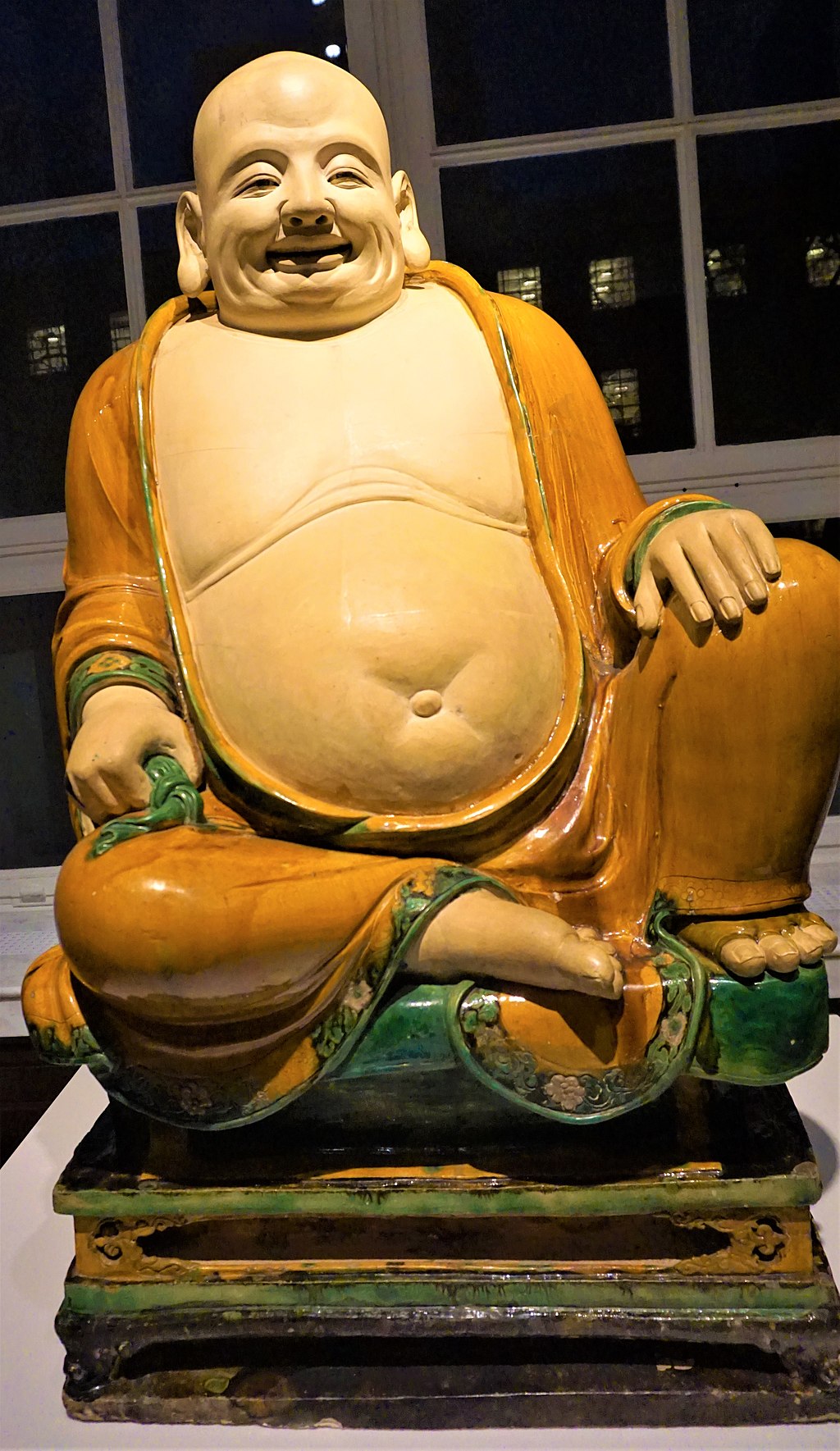
This almost life-size porcelain figure represents Budai Hesheng seated with one knee raised on a rectangular plinth. He is decorated in polychrome enamels and depicted as a fat smiling bald man with elongated earlobes and a large stomach.
The Budai is dressed in the loose amber-colored robes of a begging Buddhist monk, and he holds a sizeable green-glazed cloth bag under his right arm and the drawstring in his hand.
His robes are edged with a border of scrolling flowers and foliage. The plinth is incised beneath the glaze with a dedicatory inscription. The inscription provides the details of the date when the figure was made and the maker of the statue.
Budai is a semi-historical monk, as well as a deity who was introduced into the Zen Buddhist pantheon. He allegedly lived around the 10th century during the Liang Dynasty.
His name literally means “Cloth Sack,” and refers to the bag that he is conventionally depicted as carrying as he wanders aimlessly. His jolly nature, humorous personality, and eccentric lifestyle distinguish him from most Buddhist masters or figures.
He is almost always shown smiling or laughing, hence his nickname in Chinese, the “Laughing Buddha,” but he is not a representation of Gautama Buddha, the primary figure in Buddhism.
The “Laughing Buddha” is cherished as a popular luck charm and can be found all over the world in homes, restaurants, and places of business. Budai figures represent both contentment and abundance in Chinese culture.
As Zen Buddhism was transmitted to Japan around the 13th century, the Japanese Budai was almost always depicted with his “cloth sack” that looks like a large bag.
The bag serves as a prominent motif within the context of Zen as it represents abundance, prosperity, and contentment.
Budai Hesheng
- Title: Budai Hesheng
- Artist: Liu Zhen (according to the inscription)
- Date: 1486
- Findspot: China
- Materials: Glazed terracotta
- Culture: Ming dynasty, Chenghua period
- Dimensions: H: 119.2 cm; W: 65 cm; D: 41 cm
- Museum: The British Museum
Who is Happy Buddha?
The History of Laughing Buddha
A Tour of the British MuseumAsian Collection
- Seated Buddha from Gandhara
- Statue of Tara
- Bodhisattva Avalokiteshvara
- Avalokiteshvara – Guanyin
- Nandi – Figure of the Humped Bull of Śiva
- Garuda
- Budai Hesheng
- Luohan – Yixian Glazed Ceramic Sculpture
Africa, Oceania and the Americas Collection
- Double-Headed Serpent
- Hoa Hakananai’a / Moai from Easter Island
- Hawaiian Feathered Helmet
- Bronze Head from Ife
- Benin Ivory Mask
Buddha or Budai?
Laughing Buddha
Story of Laughing Buddha
~~~
“Habits are cobwebs at first;
cables at last.”
– Chinese Proverb
~~~
Photo Credit: 1) JOM
Popular this Week








 Sponsor your Favorite Page
Sponsor your Favorite Page SEARCH Search for: Search Follow UsJoin – The JOM Membership Program
Sponsor a Masterpiece with YOUR NAME CHOICE for $5
Share this:
- Tweet
